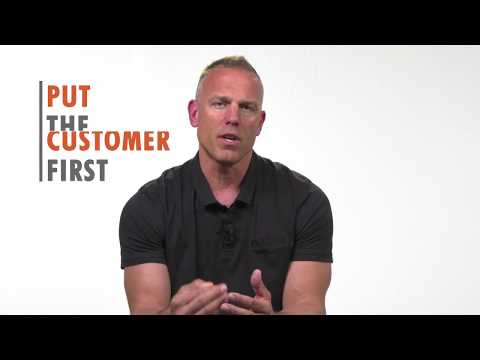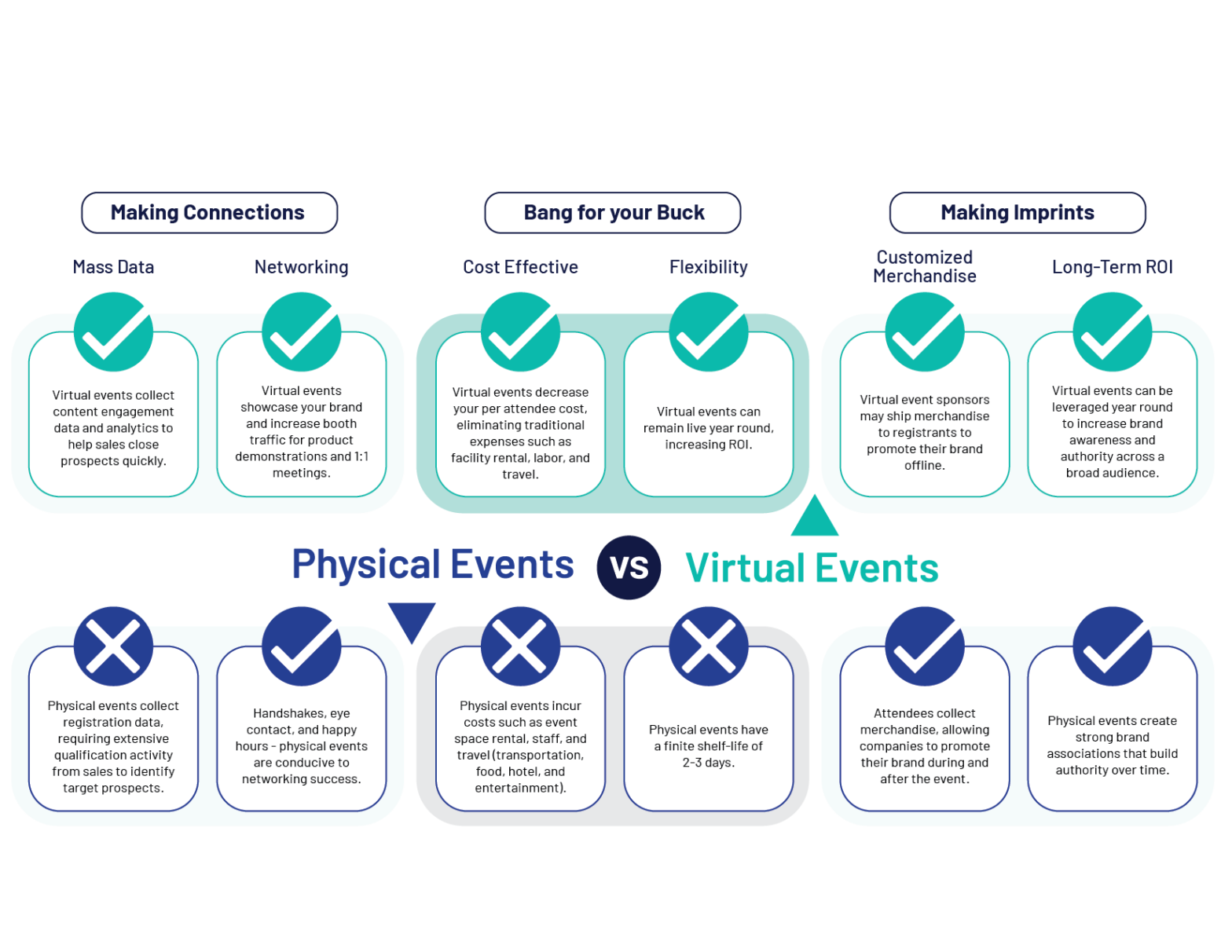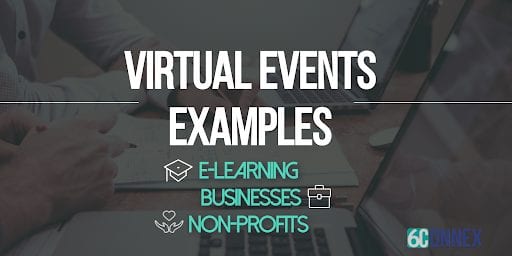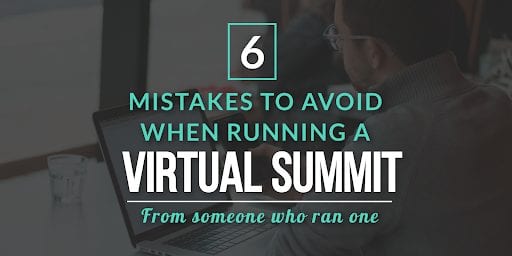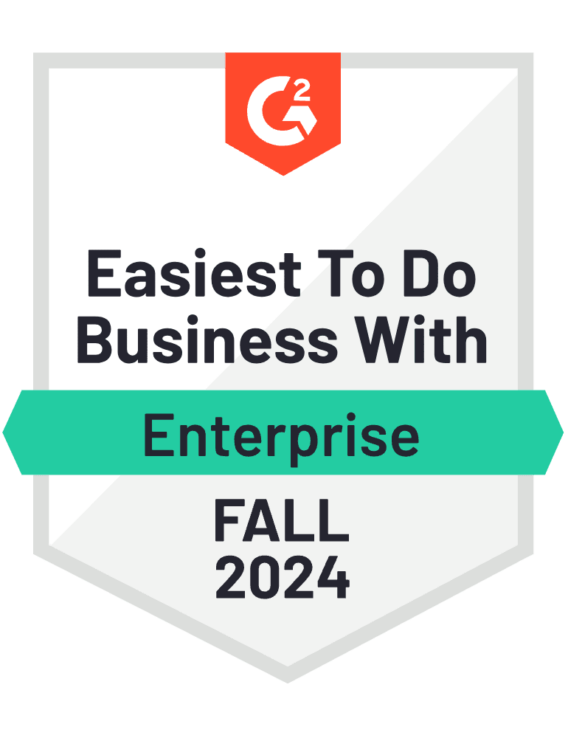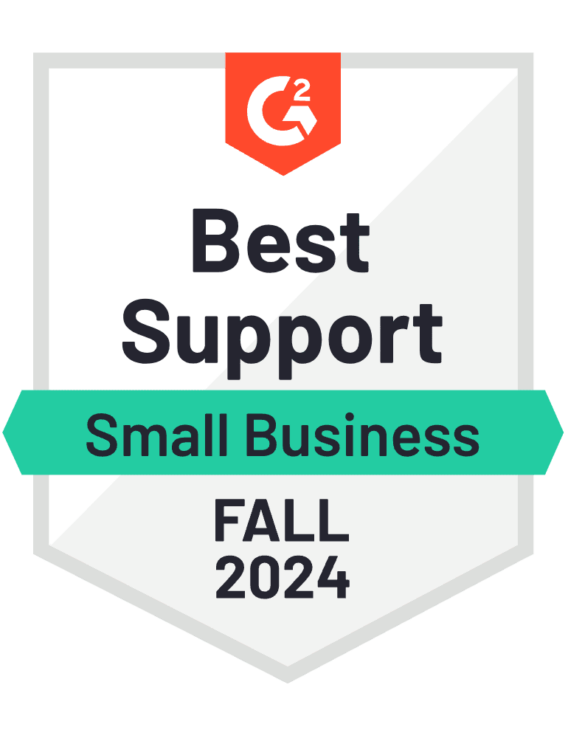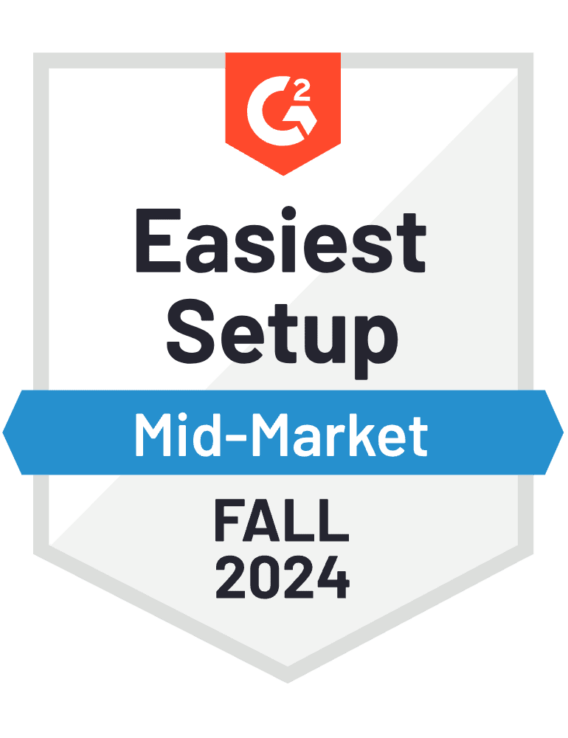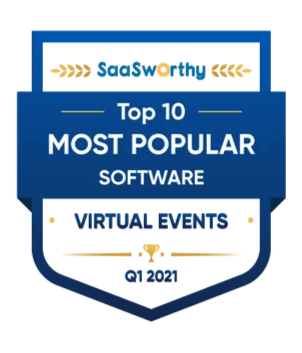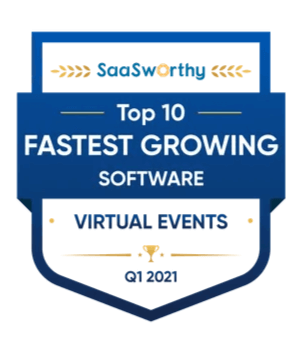SonicWall: Why We Chose 6Connex’s Platform to Improve Our Sales Kickoffs
6 Tips for Selecting the Right Virtual Events Platform
As a result of the COVID-19 outbreak, we now work in a virtual world. Meetings are virtual. Events are virtual. Training is virtual. Recruiting is virtual. In an unprecedented industry shift, companies are converging on virtual event platform providers in record numbers to deliver content to audiences–to the point where some virtual event platform providers have had to create a waitlist.

But with a deluge of complex requests, how are virtual event platform providers managing the increase in demand? And how do you choose between opposing virtual event platforms? Can you tell which vendor will be with you over the long term and which will fold after the crisis?
Following are six suggestions for determining which virtual event platform best fits your needs.
1. Will the technology actually deliver what the vendor promises? You’re pivoting to a virtual event platform on a tight timeframe. You can’t afford empty claims. Do your homework so you know exactly which features and functions are available on the market, and then create two lists: 1) “must-have” capabilities and 2) “nice to have” capabilities. This will help you determine whether the platform really meets your business needs and enable you to ignore “shiny objects.” Another key consideration: make sure the vendor can deliver on your “must have” list now, not in the future. If you learn one of your “must-have” capabilities is on a product roadmap, and not in the current product release, it’s time to move on.
2. Reputation is critical. How long has the vendor been in business? What does the vendor’s customer portfolio look like? Are some of their customers in a similar industry, of a similar size, or targeting a similar audience as you? Does the vendor have repeat customers? Can the vendor provide customer references? What is the vendor’s customer turnover rate?
3. Do not compromise on support. We can’t emphasize this one enough! When it comes to technology, things can go awry. You want to ensure your vendor is continuously doing everything possible to prevent event hiccups. The team responsible for your virtual event platform needs to be 100% invested in your event’s success and committed to their relationship with you. This type of support cannot be outsourced. It has to be in-house and you should have access to a dedicated account manager 24/7/365. Hint: when you’re checking those customer references, ask the question, “Is your support team responsive, knowledgeable, and experienced?”
4. Can the platform scale? Understand the virtual event platform’s level of customization and scalability. As you expand your audience, the platform should scale accordingly. The last thing you want is to undergo the selection and implementation process a second time because the existing platform can’t handle new or growing needs.
5. Take a test drive. Before making a final selection, kick those tires! Reputable vendors will offer a demo to showcase features, benefits, and usability. This is when you can see the platform in action and learn what it can really do. Best practice: if the platform will be used for more than one function, make sure you involve all stakeholders to participate in the demo. The platform should meet everyone’s needs (and of course you’ll want cross-departmental buy-in). Then during your demo, make sure the platform really contains your list of “must have” capabilities. Remember this isn’t just about “cool features.” It’s about meeting your requirements. Also, keep an eye on usability. As you move through the demo, take note of how many clicks or screens it takes to accomplish a specific task.
6. Insist on Key Performance Indicators (KPIs) before signing a contract. Put your new partnership to the test and collaborate with your virtual event platform provider to create Key Performance Indicators (KPIs) prior to signing any contracts. With KPIs in place upfront, both parties will know what defines a successful implementation.
Stay Focused on Creating Real ROI
Too often companies convince themselves it’s okay to down-play criteria like capability, reputation, and support in favor of a lower-quality, lesser-value platform–only to discover the platform doesn’t really meet their needs. Suddenly, they’re back to square one, perhaps even re-visiting the platform provider they should have initially selected. Following the six suggestions above will build your business case and help you identify the “best fit” platform for your business, one that offers the most value and yields a quick ROI. Have questions? Contact a 6Connex product specialist today to learn about our online event consulting services or get a demo!
Enable Social Distancing by Taking your Business Online During COVID-19
Your business must go on.
But in what may be the start of a new normal for companies worldwide, your workforce is likely remote to prevent transmission of the COVID-19 virus.
The good news: you’re not alone. Globally, employers are implementing social distancing practices at the workplace. These include reducing the number of employees in the office, asking employees to work from home, prohibiting access to common areas within offices, restricting office visitors, and using virtual environments for communication and collaboration.

And even better news: there’s a wide variety of tools and technology to help virtualize office environments and enable teams to continue to work well collaboratively and simultaneously. A 6Connex Sales War Room, for example, is a fantastic virtual environment that allows sales leaders to check in anytime, anywhere to a digital command center that tracks real-time progress to goals for every business segment. Teams worldwide receive continuous deal updates and alerts, in addition to having access to an easy, virtual way to collaborate on sales activities such as scenario modeling.
Other tools, such as e-Learning, are perfect for training internal teams or customer user groups alike. At 6Connex, our e-Learning environment is user-friendly, easy to set up, and most importantly, available across a wide variety of devices and operating systems to ensure everyone on every device has equal access. Attendees receive real-time feedback during their training course, and management can get up-to-date analyses on how courses are performing, as well as track the progress of individual participants.
And on a day-in, day-out basis, companies can’t beat live event streaming as an online alternative to in-person conferences and meetings. In fact, virtual events,with deliberate planning and excellent facilitation, can be very effective, and 6Connex has been working with customers worldwide to move various AGMs, stakeholder meetings, conferences, and business events online. While the obvious benefit is that these meetings have been able to take place as scheduled, many of our customers have also been pleased to discover that in moving their events to a digital format, there are ancillary advantages including:
- Increased attendance
- Improved engagement
- New and creative opportunities for brand promotion
- Automatic creation of Videos on Demand (VOD)
So if you, like many, are promoting social distancing and transitioning the meetings and events on your calendar to digital formats, here are three best practices to keep in mind:
1. Pick the right solution.
Virtual events can take many different forms, and the right virtual event provider will have multiple solutions from which to choose. For example, are you hosting a meeting? An event? A training program? When you’re planning an online event, think about what you want your user experience to look like.
Webinars
If you expect attendees to mostly just listen, a webinar is probably your best option. A webinar format is similar to a lecture or presentation. They’re ideal for sharing content with large audiences and may be open to the public. Typically, webinar attendees do not interact with one another. Though 6Connex provides features like a Q&A and polling to enable additional engagement, your average webinar adopts a ratio of one or two speakers to many attendees.
Virtual Events
On the flip side, if you’re inviting a large audience and you’re expecting more back and forth communication between them, a virtual event might be the better option. With a virtual event, you can host interactive sessions and invite lots of audience participation. You can even create an event environment with various “break out rooms,” where participants are assigned to virtual side sessions and can then reconvene for a main meeting.
Video Conferences
A web-based video conference most closely resembles a face-to-face meeting and is likely appropriate when the main purpose of your event is real-time, internal communication and collaboration. Participants can connect to the video conference from their desktop or device, and all participants can see and hear each other. Video conferencing is most useful for board meetings, company announcements, and team meetings where it’s critical for participants to see each other, present, and work as a group efficiently.
e-Learning
And if the goal of your meeting or event is training, then an e-Learning platform is probably the way to go. With e-Learning, you’re recreating the classroom environment, complete with characteristics like instructor-student interaction, Q&As, discussions, games, collaborative projects, quizzes, etc., but the instruction takes place online.
2. Be Prepared
Let’s face it: this is a best practice for any meeting regardless of whether it’s taking place in person or online. Create an agenda for your virtual meeting or event and distribute it in advance. (Tip: include it in the calendar invite.) If you’re new to virtual meetings and you’re using a virtual platform for the first time, be sure to take it out for a test drive and make sure there aren’t any connectivity issues. Also, be considerate of attendees’ different time zones and schedule the event at a time that’s reasonable for all participants. The goal is to host an effective event, and if you take time to prepare, chances are your attendees will be prepared as well and you’ll maximize your event ROI.
3. Utilize Interactive Features
No matter which platform you use or event format you choose, be sure to take advantage of all of the engagement features that come with it. For webinars, virtual events, and e-Learning in particular, tools such as chat boxes, Q&As, polls, and more are not only well received by attendees, but they allow you to track participation data so you can see how well your audience is responding to the digital format. And with social distancing required in some states for at least the next three weeks, this data will enable you to improve your digital events for the longer-term.
Options in the Wake of Coronavirus
While in-person interactions and meetings greatly contribute toward building relationships and fostering collaboration, virtual environments can go a long way to replicating this while still enforcing social distancing, whether the goal is internal communication, sharing thought leadership, or training new employees (because some of us are still hiring!).
Still have questions? Contact a 6Connex product specialist to learn about our online event consulting services or get a demo today!
The Show Must Go On: How to Leverage Virtual Events to Protect your Employees from COVID-19 during Trade Show Season
On the heels of the World Health Organization’s declaration of the Wuhan coronavirus as a global emergency, some of the world’s largest trade shows have been disrupted. Sponsors and attendees alike are downgrading or withdrawing their participation, prompting event organizers to postpone and even cancel their events. Stated communications service provider Ericsson upon its withdrawal from the 2020 Mobile World Conference, “Ericsson appreciates that GSMA have done everything they can to control the risk. However, as one of the largest exhibitors, Ericsson has thousands of visitors in its hall each day and even if the risk is low, the company cannot guarantee the health and safety of its employees and visitors.”
One way event planners can guarantee the health and safety of employees and visitors: a virtual event platform. A virtual event is like a live trade show, except as the name implies, it takes place virtually, or online. Going beyond just a webinar, the technology allows individual users and businesses to enter a virtual, accessible 3D event space, where attendees can visit trade show booths, watch live webcasts, and interact with each other in chat rooms (complete with translations if necessary). They can download product sheets, presentations, and videos… at approximately 75% less than the cost of live attendance and all without the hassle of airport security, hotel check-in lines, or in the case of today’s headlines – the risk of contagion.

Even better for those companies leveraging trade shows to identify the almighty lead: virtual event visitors’ behavior is tracked, analyzed, and visualized, allowing companies to truly understand who their potential buyers are and where they may be in the buying cycle. Added bonus: these leads are available in perpetuity. With a virtual event, companies have the ability to create new sales over and over. Once they’ve built the event, they never have to break it down. They can keep using it over and over again. They’ve now established a new community.
Additional benefits include:
Wide Reach: Everyone can attend an online event, irrespective of their location. A virtual event is a great opportunity to connect with a wider, international audience and make connections with peers, prospects, and experts with whom attendees might not have crossed paths at a physical event.
Companies can also expand their reach by offering both a physical and an online experience, or a “hybrid” event. Hybrid events often draw a larger crowd, and in a hybrid event, there are more voices in the dialogue. For example, the virtual moderator can lead discussions on social media or the event platform during the event as well as interact with the live audience during a break.
And in the case of the unexpected, such as a virus outbreak, a hybrid event allows companies to choose how they would like their employees to experience the event’s content, networking opportunities, and product demonstrations. For those companies who prefer a face-to-face experience and feel comfortable allowing employees to travel, the opportunity is there. And for companies like Ericsson, who are unwilling to allow employees to travel amidst virus concerns, there’s no need to forego participation.
Cost-Effectiveness: Physical events come with a laundry list of expenses: venue rental, staff, travel, food, hotels, and entertainment. A virtual event eliminates many of these line items, not to mention speakers often charge less and registration numbers increase because everyone on a global team can attend.
Low Carbon Footprint: Compared to traditional trade shows, virtual trade shows are “greener,” and lowering environmental impact is an increasingly important goal for many companies, especially in a world where consumer buying groups are making purchasing decisions based on a company’s commitment to the environment. Tax incentives for cutting fuel costs are also likely to increase, making virtual exhibits an even more attractive proposition.
Intelligent Lead Generation: Traditional trade shows often generate exciting leads. Unfortunately, 80% of those leads are never contacted again – a statistic bound to discourage the most enthusiastic marketing professional. The reasons are myriad: disconnects between marketing and sales departments, the difficulties of reading hand-scribbled names and addresses, the tedium of entering contact information by hand into databases. However, virtual trade shows assume responsibility for collecting the data – and most include built-in lead management software. Suddenly tracking leads becomes simple. In addition, many systems offer tags so sales reps can make notes on attendees or companies, making post-event contact easy.
Also, virtual event systems generally allow companies to run analytics as soon as the show is complete. Instead of entering all of the data separately, the virtual trade show tracks and analyzes it and generates reports. Sales can chase leads immediately, which can greatly improve return on investment.
Opportunities to Connect with Next Generation Buyers: Virtual events help companies connect with the digital generation. Over time, the digital generation will comprise the majority of corporate decision makers, and this generation will be at least as comfortable with the virtual world as they are with text on a page. Gaining experience now in the virtual world will give companies an edge in marketing to this vast demographic.
Productivity: When an employee is at a trade show,he or she is out of pocket. Valuable time is spent traveling and attending the event itself. And for event sponsors, let’s face it: just putting up and taking down a booth can be a day’s work in itself. A virtual event, however, allows the employee to visit and revisit the experience on their own terms, increasing the attendee’s productivity, the conference’s value for the attendee, and its ROI for the event producer. And virtual events tend to be faster paced than those in real life since the attendees don’t have to physically move from space to space. This means attendees can actually meet more people.
The Search is Over
As companies strive to protect the health and safety of their employees as well as the employees of their customers, partners, and vendors, they’re taking all necessary measures to ensure no one is put at risk: restricting travel, limiting the size of meetings, providing remote-work solutions, and continuing to insist on safe behavior in every environment. One easy and safe way to conduct “business as usual” in this environment is through the use of virtual events. To learn more about how you can leverage virtual event technology in your own organization, request a demo today.
Virtual Events vs. Physical Events: The Definitive Pro-Con List
Virtual event planning software is clearly on the rise, with lead generating virtual events consistently proving themselves as the most powerful weapon in the digital marketing arsenal.
With such powerful results, multi-sponsor marketing events that have always been predominantly physical are now turning into virtual summits. Companies are learning how to connect with attendees through virtual booths and sponsored sessions.
But all of this commotion begs the question… what are the real differences between physical and virtual events?
For those of you thinking about replacing a physical event with a virtual event, here is the definitive pro-con list of physical vs. virtual events from the perspective of a virtual event insider.
For visual learners, here is a handy infographic summing it all up. If you need a more elaborate breakdown, scroll down a bit more.
Differences Between Running a Virtual Event and a Physical Event: Pros and Cons
In this section, we are going to breakdown the biggest differences between virtual events and physical events, weighing both the pros and cons of each difference.
1. Cost-Effectiveness
One of the best parts of an in-person event is coincidentally one of the most expensive: travel.
Traveling to a new city or stomping ground is exciting and can help employees shake the daily grind, but it is also extremely costly. Costs for physical events include the following:
- Renting event space
- Hiring staff and caterers
- Booking live entertainment
- Paying for employee travel costs
- Putting speakers up in hotels
… you get the picture.
There is definitely something to be said for changing it up and giving attendees a memorable experience in a new city, but it’s going to cost you.
Fortunately, there is a simple alternative.
Virtual event companies offer “virtual venues”, 2D or 3D event spaces that can accommodate all of your employees and guests, no matter where they are in the world (and if you have a battle-tested virtual platform provider like 6Connex, you can even invite the entire internet if you so please).
But wait, it gets better…
In-demand speakers will agree to speak for a fraction of the price at virtual events because of the convenience. You can afford better speakers (and more of them) for the same price.
What does that mean? For marketing events, more high-quality speakers translate into more potential leads.
Bottom line – virtual events are more cost-effective but do not have the benefits (or setbacks) of travel.
2. Flexibility
Our workforces have gone global. Our employees are in every corner of the globe, and more and more of them are working remotely.
How do we accommodate our growing workforce?
Virtual event solutions have emerged to solve the problem of different time zones and varying schedules.
As exciting as travel is for employees, the time it takes to plan, fly (often internationally), and drive to the hotel can amount to excessive “dead” time where emails pile up and calls get pushed – not to mention the time blocked off on the calendar for the conference itself.
And what if some people can’t make it?
Physical conferences sometimes provide access to the presentation decks after the event and sometimes offer recorded sessions for later viewing. But in general, once it’s done, it’s done.
Smart companies run virtual conferences with the idea that attendees will come back again and again.
Maybe there were too many great sessions playing at the same time, or attendees want to grab some collateral to share with their CEOs. Whatever the need, virtual event attendees can revisit the experience on their own terms, increasing the conference’s value for the attendee and its ROI for the summit producer.
The flexibility medal goes to virtual.
3. Mass Data
At in-person events, whether internal or external, the extent of the data collected is usually a handwritten sign-in cheat.
Virtual events, on the other hand, are master data-miners.
Hot leads leave all kinds of clues into their buyer journey – what type of content they’re viewing, which sales reps they’re talking to, which attendees they’re engaging with, and what resources they’re downloading.
The best part? All exhibitors can access this data, grow their e-mail lists, and nurture leads better than ever before.
If you want big data, go virtual.
4. Networking
The battle royale of Face-to-Face vs. Interface-to-Interface.
In a world where we spend so much time online, sitting in front of our laptops or staring down at our mobile phones, it’s nice (even special) to look someone else in the eyes when you say hello.
Meeting people in person that you’ve only ever spoken to on the phone or via email adds an important layer to the relationship, allowing for a different kind of communication.
Although virtual event providers have advanced chatting technology, making it exciting and engaging for attendees to chat within the event, the world still needs handshakes.
However, over in the buying experience department, networking can actually be easier virtually.
Let me explain.
Attendees are generally interested in seeing what vendors have to offer. There are tons of tools out there that we don’t yet know about, and by chatting it up with booth reps on a virtual events platform, we can learn a lot about what’s new and what’s possible, all without feeling the pressure of buying anything.
Finally, let’s be honest… we don’t REALLY want to chat with everyone.
At a physical event, we often avoid eye contact or try to browse datasheets while dodging overzealous sales reps. In virtual summits, we can take our time and browse what we want when we want. It is a much more relaxing experience.
Bottom line – no chat box will beat a real handshake, but uninhibited sales inquiries are often better for business. If you’re curious about taking your next exhibition online, learn more about virtual trade shows.
5. Personalized Merchandise
I admit it – even as a virtual summit veteran, I still pick up conference t-shirts and peruse booths for the best freebies to take home, even though the last thing I need is another water bottle.
Personalized merchandise is a fun and engaging part of in-person events, although when I think of packing that swag in my suitcase, I start to reconsider…
I can almost hear you thinking “Can’t virtual events create merchandise as well?”
The answer? Yes, they can.
Although unnecessary, t-shirts are often shipped out to staff to wear in videos or given to speakers with the option of recording their videos in the personalized swag.
Some marketers even offer exclusive merch to All-Access Pass participants for a personalized touch.
Our conclusion? Everyone loves t-shirts. In-person events are king in merchandise.
6. Long-Term ROI Effects
Long-term ROI is difficult to measure right away.
Both physical and virtual events leave strong brand associations in the minds of the participants.
The difference is that virtual events are able to run longer, accumulate more leads, and reach more people. The big data acquired during the event also leads to a ton of revenue in sales as a result of lead nurturing.
The victor? It depends on your company’s goals, but the possibilities with virtual events are virtually endless.
Is Your Company Ready to Run a Virtual Event?
Will virtual events lead to the demise of physical events?
We’d say never. People are still people – at the end of the day, they want connection. But they also want convenience.
Many opt for a hybrid event that combines the two, with live streaming, repeat days, or any number of the many options that add value for physical attendees while extending reach to virtual attendees.
There’s a place for both in any marketing mix. When you’re ready to go virtual, give 6Connex a call to book a demo and discover how virtual event software can help grow your business.
A Webinar Follow-up Strategy that ALWAYS Generates Leads
After a webinar, you create e-mail campaigns, keep in touch with prospects, or repurpose the content into other content mediums, among other webinar follow-up best practices.
And if you’re like most, you probably post the on-demand link somewhere on your website and watched views trickle in overtime.
But what if there was another strategy to generate leads from your webinar LONG after it is over?
Use a Webinar Theater to Generate More Leads
The trick to getting more leads from your webinars is by surfacing the older webinar topics to both new and old prospects, in one place.
A webinar theater is a virtual home for ALL your webinar content, both live and on-demand. With a theater, you can drive registrations for new individual webinars, while providing access to a library of existing resources from past webinars.
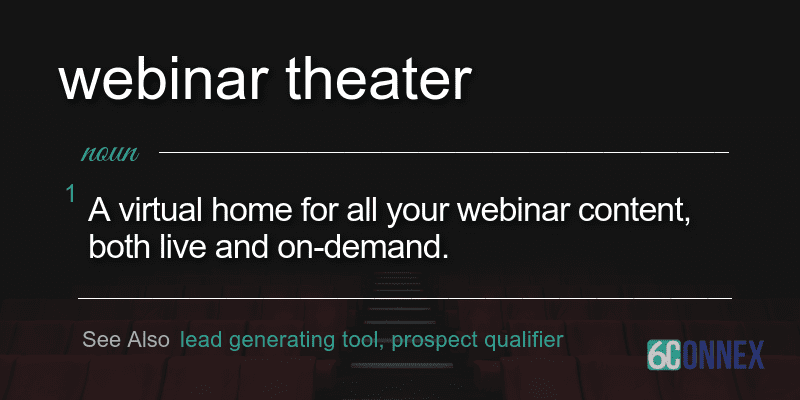
You don’t want to repeat yourself, but hey, that presentation from February may be just what’s needed in October to push a prospect to close.
Consider adding a webinar theater for all the webinars you have hosted, and the ones you will host in the future, in one place.
After a Webinar: Strategy to Qualify Prospects
With a theater, you can let your marketing program cross-pollinate while your prospects self-select the content they need in the theater you set up. This way, you can continue qualifying prospects for webinars done in the past.
Here are features available in a webinar theater that can help you qualify prospects at any time:
- 1:1 room chats
- Small groups and public chats
- Social sharing capabilities
- Surveys, polls, and tests
- Detailed reporting to create a valuable picture of each prospect over time.
Adding the above features to your current vault of valuable content takes your lead generation through webinars to a whole ‘nother level.
How Webinar Theaters Help Improve Conversions
Posting your webinars online is a great first step in repurposing your content and getting more value. However, the above-mentioned features from a webinar theater give some added bonuses to your valuable content for lead generation.
Increase ROI
You have limited time and resources, so making the most of every piece of content is critical. If you can drive more views for your on-demand content, you can engage more customers and prospects, squeezing more ROI from each webinar campaign and stretching your budget just a bit further.
Qualify Prospects With Real-Time Data
With real-time analytics and reporting, your sales team has 24/7 access to data from virtual attendees. In the theater, you can see where attendees are clicking and what information they are interested in – all to help you qualify prospects and nurture leads more easily after the webinar has already been live.
Gain Authority in Your Industry
Using webinars as part of a content marketing strategy is increasingly popular because they allow you to demonstrate thought leadership and interact with audiences to create engagement, which you can measure through the unique tracking capabilities.
Follow-Up On This Webinar Strategy
If you have webinar content that can act as a lead generating tool long after the live date, then try setting up a webinar theater for your content today. See how your webinars will look using 6connex’s virtual events platform by trying our demo today.
Virtual Events Examples: E-Learning, Businesses, & Non-Profits
The most common virtual events that companies create include virtual trade shows, virtual job fairs, virtual sales-meetings, company-wide gatherings, or virtual summits.
Virtual events are not limited to these areas, however – any type of program that requires the attention of a large audience in one place can go virtual using a virtual conference platform. This includes customized learning experiences for e-learning opportunities or virtual fundraising ideas for non-profits, for instance.
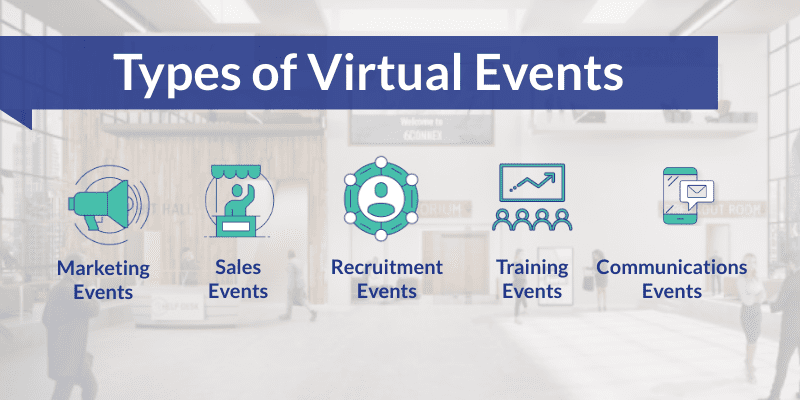
Whether you host virtual events for education purposes or for the dissemination of company information, these environments can be extremely effective in reaching the objective you have for the people you want to reach.
Continue reading to get the full coverage on what a virtual is, the different types of events, as well as the different elements that will bring your virtual program to life.
What is a Virtual Event or Virtual Environment?
At a basic level, virtual events are very similar to physical events. They enable groups of people to come together to learn, discuss, and interact. Virtual attendees consume content, exchange contact information, and can even receive training or learn new material the same way you would in a classroom setting.
The only difference from the physical is that online events happen through a virtual conference platform where all resources can be conveniently downloaded and people’s interactions or progress can be tracked.
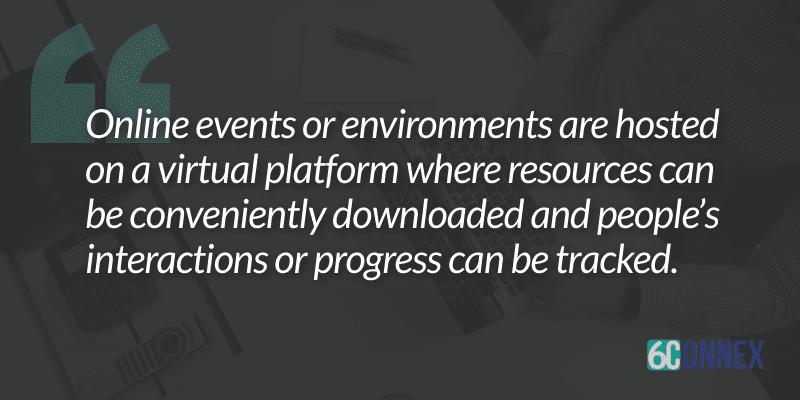
So, what kind of virtual events can you host and what kind of virtual environments can you create?
Virtual Events Examples for E-learning
Educational organizations are adding virtual events to their curriculums to engage students with highly-interactive immersive learning experiences. These e-learning environments can be used for educational content such as:
- Training programs
- Course programs
- Certifications
- And more
Virtual Educational Environments
With supreme virtual conferencing tools, the learning opportunities and engagement possibilities are endless – students can take a tour of important landmarks, for instance, or actively participate in discussions about a topic in real-time or on-demand.
Students can delve deep into any subject matter with knowledgeable experts near and far, so location is not a deterrent. With video chat capabilities, students can instantly engage in cultural and social events and meet other students in a relaxed and fun way.
Take administrative control of a student or attendees progress with the following features a virtual event platform offers:
- Entitlements and learning sets
- Quizzes and polls
- Tailored curriculums
- Tests with auto-scores
- Course completion tracking
- Virtual mentoring
- 1:1 chat rooms
- Group chat rooms
- Real-time reporting
- Gamification
- LMS integrations
If you are looking for a virtual platform that can host your educational content, learn how 6connex can help.
Virtual Events Examples for Businesses
There are many types of virtual events. Some of the most popular virtual events for for-profit businesses include:
- Virtual trade shows
- Virtual marketing summits (B2C or B2C)
- Virtual product launches
- Industry conferences
- Virtual ABMS
- Virtual sales conferences
- Sales resource enters
- Virtual partner events
- Partner training centers
- Virtual employee benefits fairs
- Internal training
- Virtual job fairs
- Certifications
- Learning management
- Company news
- Executive updates
- Townhall meetings
- Critical communications
- Virtual expositions
Your imagination can run wild here. As mentioned before, any type of event that requires the attention and engagement of a large audience can be hosted online. For a business, most of the above events fall into the following areas of types of virtual events:
Virtual Fundraising Ideas for Non-Profits
Virtual events are not only reserved for educational purposes or for businesses. There are virtual event opportunities in the non-profit area as well. For instance, non-profits can use online events as a creative marketing strategy for virtual fundraising ideas they want to execute.
All types of organizations can make the most of a virtual event to share information, market to their audience, and accomplish their strategic organization’s goals.
But just how do you do it?
How a Virtual Events Software Brings Your Program to Life
Now that you know the basics of what a virtual event, it’s time to see what one actually looks like and get a feel for how virtual participants would interact one.
Visuals
In the visual layer, you can include background images and graphics to provide a sense of space and context for the content. Often, visuals are created to look like physical rooms and spaces, making navigation for attendees or students very intuitive.
Using signs for directions and promotion is another way to guide attendees to participate throughout the different parts of a virtual environment.
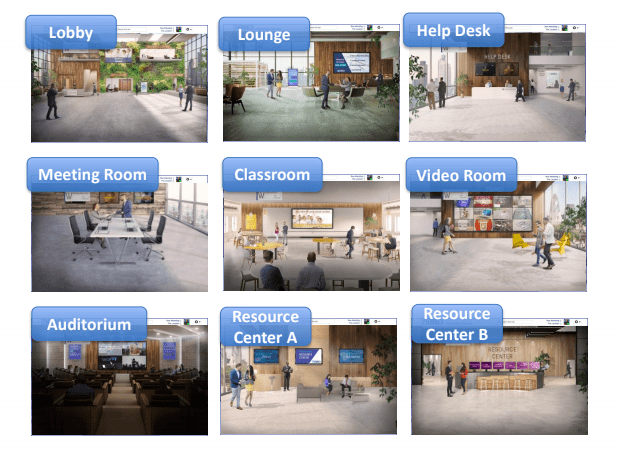
The way your virtual event will look is entirely up to you. For keynote presentations, for instance, you can create a space that resembles an auditorium for attendees to feel like they are watching a keynote speaker in a physical event.
Depending on the audience – and particularly for younger attendees – our virtual events team has noticed a surge in the use of hybrid events. This type of event would not necessarily have to resemble a physical location and simply uses a regular screen for attendees to watch while the virtual event takes place.
Something to consider for future events as you plan for a different kind of audience.
Interaction
The interactive layer is where actions occur over the visual background. This is where the flexibility and the power of the virtual events software come into play. Some interactive elements virtual attendees can engage in include:
- Watch webinar presentations
- Participate in live streaming videos
- Talk with peers in group chats
- Share content on social
- Download content
- Request meetings/demos with staff
These are just a few activities you can offer for virtual attendees. You can take it to the next level and gamify the experience as well. Games like treasure hunts or fun prize giveaways can be tied to these actions, creating more energy and interactivity for virtual participants.
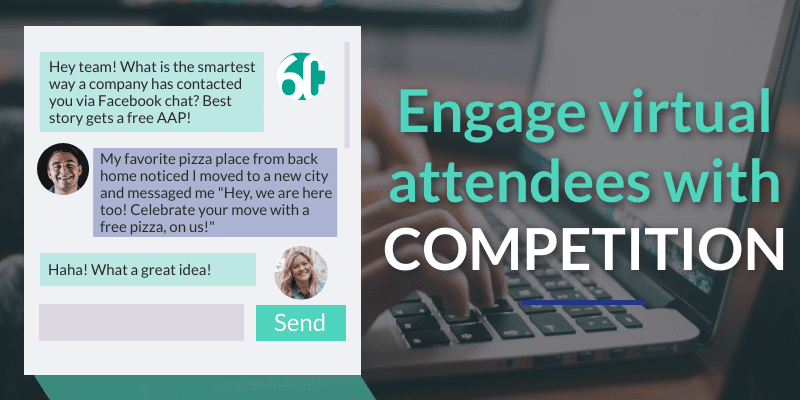
Engagement that just doesn’t end
Even when an event is not live, a virtual environment can remain open for anytime access, 24/7, allowing for more opportunities for attendees to participate in an event after-the-fact or for students to continue learning and engaging in their learning environment.
Track Data of Your Virtual Summit
24/7 access gives you 24/7 data to every part of your virtual environment. The data and metrics layer is where every action is tracked for measurable results.
E-learning Tracking
In e-learning platforms, you can track how much a student is learning at any time through the use of real-time dashboards and scheduled progress reports. The reporting and metrics for e-learning opportunities include:
- 24/7 access to a learner’s progress
- Detailed course reports
- Individual activity reports
- Quiz, text, and poll results
- Chat and engagement reports
Virtual Events Tracking
For virtual events, producers can access real-time reports of the interactions at an event or after an event, giving deeper insight into user behavior and content preferences, which translates to ROI calculations and a true understanding of program impact.
This is one area truly unique to online events. Hosting events virtually allows for the valuable data collection of virtual participants in real-time – a MAJOR benefit for any type of virtual event program.
Start Planning Today: Find the Right Virtual Events Platform
If you want to learn more about types of virtual events, check out our blog for more resources on hosting an online program.
If you are ready to start planning, make sure to choose one of the best virtual conference platforms available to host your tradeshow, e-learning coursework, or certification. Request a 6Connex demo to see how our team can help you execute any virtual event or program.
Top 6 Virtual Trade Show Benefits: Why Opt for a Virtual Trade Show?
Advances in virtual trade show software have paved the way for the exceedingly popular movement towards all-virtual sales experiences. Exhibitors and event marketing professionals everywhere are championing virtual trade shows for their relatively low costs and substantial ROI.
Here’s why:
The ability to generate qualified leads directly from your office without having to run up expensive travel bills makes virtual trade shows extremely attractive. Lower barriers to entry also mean that virtual trade shows attract more diverse exhibitors and attendees, creating massive online audiences for companies to share their innovations with.
How do we know? The numbers prove it.
Virtual events rank as the second most important source of information considered by big business decision-makers when it comes time to invest in new technologies, according to Forrester’s research.
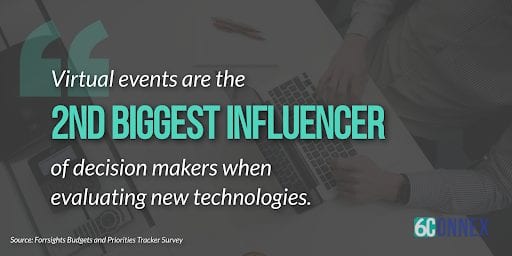
If you haven’t considered it yet, these benefits for working with a virtual platform for your trade show will change your mind. Let’s take a closer look at the top virtual trade show benefits.
1. Event hosts and exhibitors save a ton of money on resources.
You guessed it… more money in your pocket!
Virtual trade show events mean hosts and/or exhibitors can save a ton of money on travel, lodging, promotional items, and other costly expenses typically associated with trade shows.
The reduced cost of virtual exhibiting allows many more exhibitors to participate, which increases the value of the trade show itself.
But wait, it gets better…
2. Virtual events bring more attendees (a.k.a. qualified leads).
The larger pool of exhibitors is only surpassed by the even larger increase in attendees.
Stay with us here. Virtual conferences are easier for attendees to join because there is no travel involved (particularly international) and there is no minimum space requirement, so you can fit as many as you’d like. Come one, come all, from the comfort of your laptop or smartphone.
The best part?
Online trade shows and exhibitions allow you to track those self-qualified leads in the following manner.
3. Big data captures information you just can’t get at physical events.
At physical conferences, you usually just get a standard attendance report.
At virtual conferences or virtual exhibitions, reporting and analytics track every move attendees make. You know how they came, where they went, what they did, with whom they chatted, what they tweeted, which videos they watched, etc.
Here’s the best part:
On the lead nurturing front, you can even run analytics on content located in the event. By knowing how many attendees viewed and/or downloaded a piece of collateral, you can tailor your future content and conversations around the content that your qualified leads found valuable.
We’ll explain.
As hyper-personalization in virtual events becomes the norm, this data will contribute to your follow-up strategy, giving high-value content and personalized CTAs based on specific user’s interest.
Historically, this data has been virtually impossible to track.
Now, the aforementioned lead data collected at virtual trade shows can actually be collected and redistributed for all exhibitors. The data compiled is readily available to all of the exhibitors involved, which allows for smooth lead capture if you are using the right virtual trade show platform.
The 6Connex virtual trade show platform features, for example, provides integration directly into many of the top customer relationship management (CRM) systems including Eloqua, Salesforce.com, and Marketo, making capturing leads and funneling them to the correct channels a breeze.
4. Virtual trade shows give exhibitors increased exposure.
Virtual events and virtual trade shows have longer lifespans than their physical counterparts.
What does that mean?
Where a physical conference might last 1-2 days, a virtual conference can have as many live days as you’d like.
Not only can you go live longer, but with the right virtual trade show platform, you can also leave the event on-demand for 30, 60, 90 days, or opt for permanent access to booths, presentations, documents, videos, etc.
Here’s why that’s important:
Permanent access to your virtual exhibition online will create residual SEO juice for your brand and generate a substantial amount of leads LONG after the doors to a physical trade show would have closed.
Now that’s just good business.
5. Various forms of media enhance the sales experience.
What’s the fundamental goal of virtual trade shows? It’s to allow for the same type of interaction that is available at traditional trade shows without the high costs of travel and purchasing trade show booths.
Virtual trade shows often integrate instant messaging, seminar technologies, podcasting, and other means of communication into a single, smooth operating environment.
Is a smooth sales experience that important? The answer is a clear yes.
Online shopping statistics show us that companies with strong omnichannel engagement retain 89% of their customers.
For this reason, virtual trade shows are becoming one of the most popular ways for companies to communicate their messages quickly and effectively, exhibiting their innovations to mass online audiences.
6. Attendees and exhibitors engage at an unprecedented rate.
We can almost hear your thinking “…but my attendees want to network with other attendees and exhibitors!” However, this common misconception couldn’t be further from the truth.
Virtual trade shows actually make it easier for attendees to interact with each other and sponsors.
Attendees can now create their own online profiles, interact in event-wide group chats, and engage in value-packed conversations with other participants. Additionally, electronic business cards can be swapped with just a keystroke.
What about sales reps?
Chatting with booth reps becomes a breeze with virtual because attendees feel they can ask questions uninhibitedly, attaining all the information they need without ever fearing they’ll miss a seminar or keynote speaker.
All the data accrued from chats and interactions are stored in a database and allow you to better nurture your leads post-event.
It’s time to use a virtual trade show software: get started today.
The virtual trade show is a growing tool in the marketing and training arsenal.
Although physical exhibitions may never go extinct, reliable virtual trade show platforms make it easier than ever to extend your web of industry contacts and gain more qualified leads, all while effectively improving your company’s bottom line.
If you’re thinking about hosting a virtual trade show, download our free Virtual Event Planning e-book to get started. For more information, get in touch with a rep at 6Connex to see how we can help you get started today.
6 Mistakes to Avoid When Hosting a Virtual Event
The fierce competition for attention in today’s virtual world makes it all the more important for businesses to scout out fresh ideas that will help them engage with their prospective clients.
Many marketers have picked up on the new valuable trend of hosting virtual summits: An educational, webinar-like event growing in popularity among organizations for their amazing lead generating abilities.
Before blindly running off to host your own virtual event, we’ve set up a virtual summit checklist of top mistakes to avoid from an experienced virtual veteran so that you’ll end up getting the most bang for your buck.
What is a Virtual Summit?
If you are wondering “what is a virtual summit?”, then read this next part.
Virtual summits are akin to physical events (keynote speakers, seminars, networking, etc.) only they are held in virtual environments, accessible from anywhere in the world with a WiFi connection. Check out this physical vs. virtual events infographic for more details.
Virtual events can help businesses gain authority in their industry and increase ROI for digital demand generation, and advances in virtual summit software have made it extremely easy to run your own.
Hosting online conferences can seem daunting at first, but if you find a virtual summit platform with a team that offers 24/7 support and guidance throughout the process, you’ll quickly discover that it’s easier than you think.
For a more in-depth look at planning your own virtual summit, download our free e-book.
Before You Begin: 6 Costly Mistakes to Avoid
The best way to learn is by doing! Lucky for us, we know a virtual pioneer who has paved the path for us.
Kara Widdison, Marketing Manager at SnapApp, is our 6Connex case study subject for this article. She sat down with us in our own virtual theatre to go over lessons learned through her experience running a virtual summit.

SnapApp Innovation Marketing Virtual Event with 6Connex Virtual Event Software
This is her virtual summit checklist of the top 6 things to avoid when hosting a virtual summit.
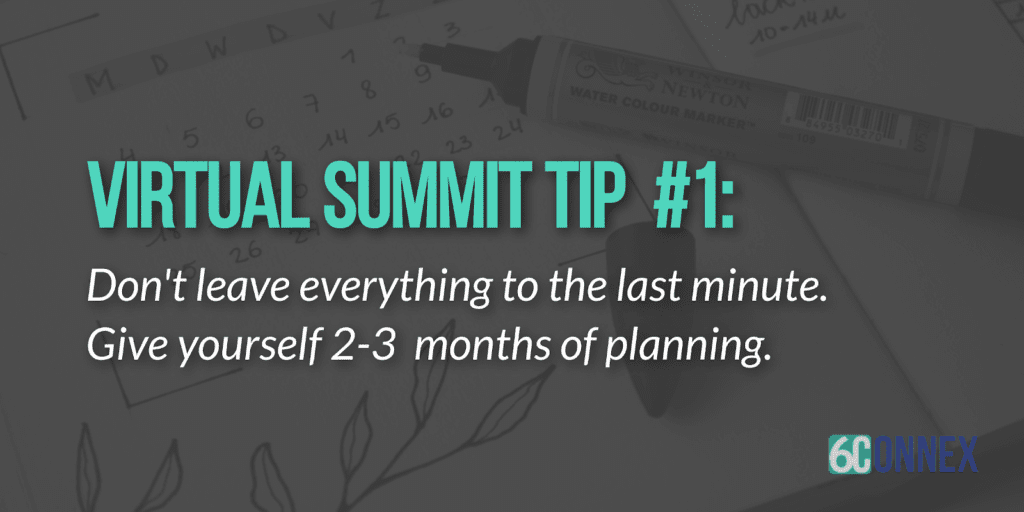
1. Don’t Leave Everything Until the Last Minute
In our meeting, Kate shares that “timing is everything” and that you should plan for a virtual summit well in advance.
She recommends planning 2-3 months before a summit so that you can have plenty of time to get everything in order.
There is much to think about when planning a virtual summit so make sure to give yourself enough wiggle room for anything you might have missed or for any problems that might come up. Kate recommends having everything set up a week before the actual summit.
Not only will you thank yourself later for organizing everything ahead of time, but so will your partners and sponsors for the extra time they will have to get their presentations ready.
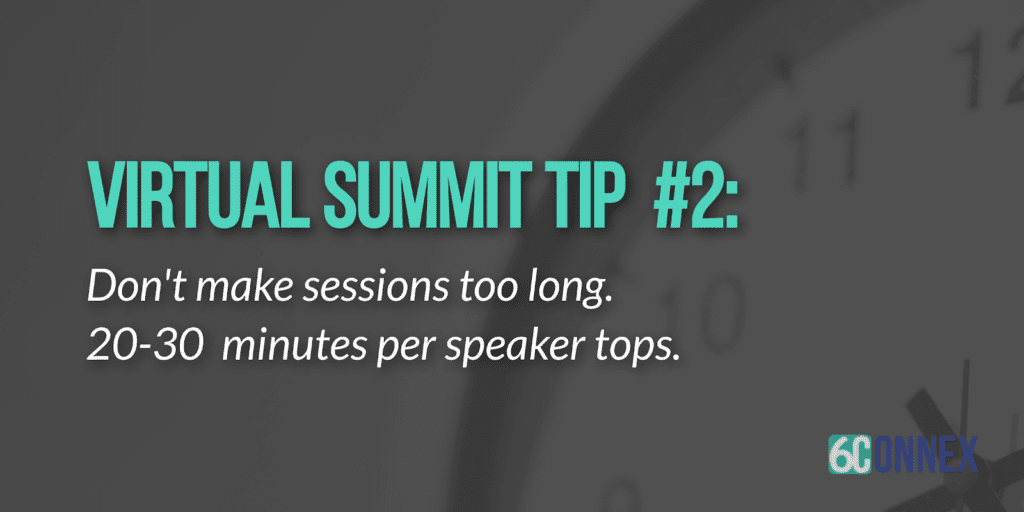
2. Don’t Make Sessions Too Long
People’s attention spans seem to be getting shorter by the second. I mean this quite literally!
If you want participants to stick until the end of a session and be engaged throughout the entire conference, cap session durations at 20 minutes max. Attendees generally stay in sessions between 10 and 20 minutes so try not to push this limit.
If speakers are worried about getting enough information in their talks, they can always add resources to complement their sessions in the virtual platform!
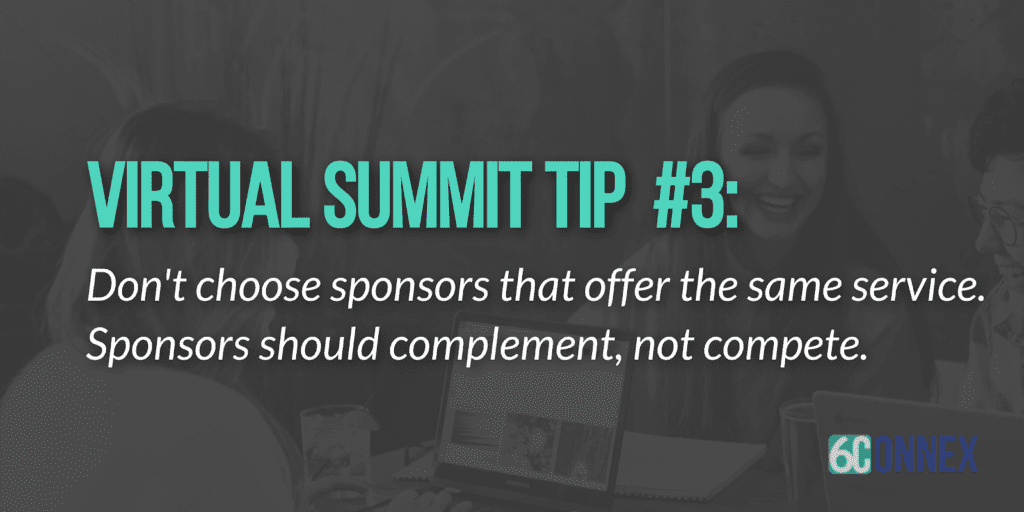
3. Don’t Choose Sponsors That Offer the Same Services
Kara pointed out the importance of finding and securing virtual event sponsors that complement each other rather than compete with each other.
You don’t want sponsors pitted against one another during your conference, so make sure you find ones that offer different kinds of services.
Be strategic with the sponsors you bring on. Think about any partners you currently have or integrations you have with different products and leverage those in your summit to reach out to an audience you “already know matches your ideal lead”.
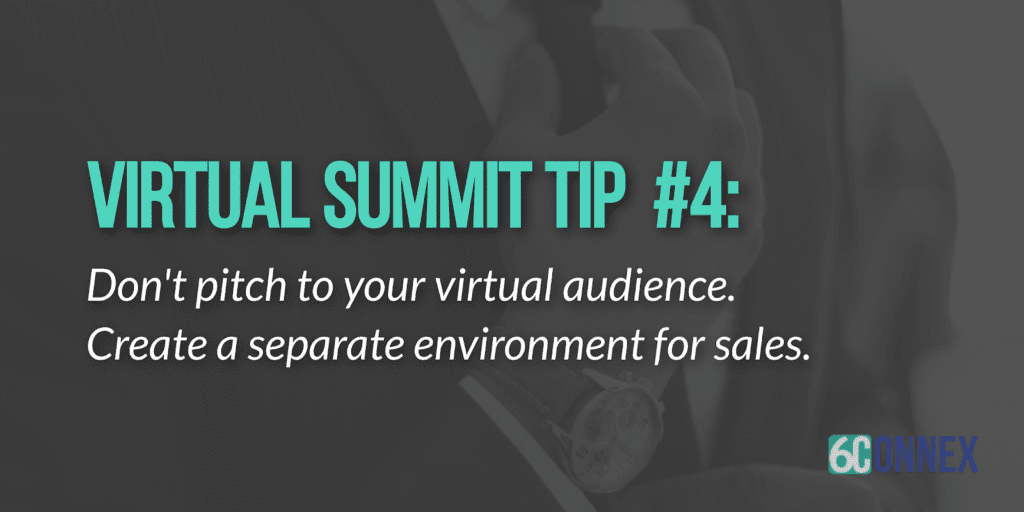
4. Don’t Pitch Your Virtual Audience
There is nothing more awkward than hearing an unwanted pitch during what you thought was a no-strings-attached session. Although speakers might want to highlight their own services, the general rule is to avoid pitching to your audience during a session.
There is a time and a place for everything and you should use the different capabilities in a virtual platform to pitch to attendees when appropriate.
Here is an example of an appropriate way to do this:
In the 6Connex virtual event platform, you can do this by offering prospect sections and customer-focused sections in different spaces in your online summit. Attendees can actively go to inquire about features, instead of being forced to listen to a sales pitch.

5. Don’t Forget About The Value of Current Customers
An additional tip Kara mentioned in our virtual meeting was to not forget the value of current customers in demand generation.
But what does that mean?
Virtual summits offer the perfect place to keep engaging with customers by offering them more resources and value in a convenient way. Make sure your virtual platform has the tools that make this convenience possible.
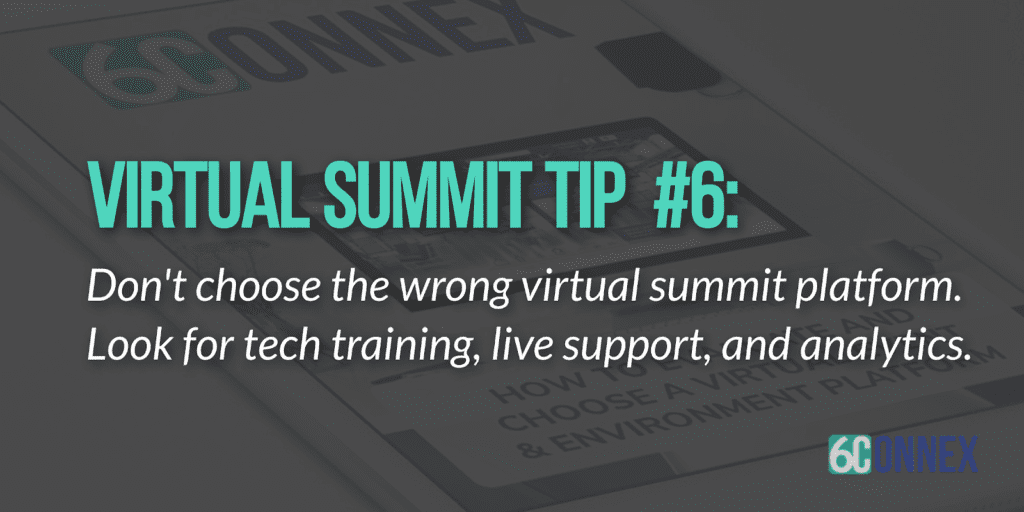
6. Don’t Choose The Wrong Virtual Summit Platform
Many businesses make the mistake of choosing a virtual platform that doesn’t fit their needs.
That is why it is important to evaluate different virtual platform providers and choose one that checks all the right boxes to help you deliver an online summit that exceeds everyone’s expectations.
Kara mentioned the importance of choosing a platform that can support a business in every stage of the virtual summit process.
From tech training done before the summit to live support on the day of the event, Kara praised 6Connex for helping her get through the entire event fully equipped.
Remember to look out for a virtual platform provider that provides intuitive tracking tools so that you can monitor where people’s attention is going.
This is extremely important because it helps you qualify hot leads and disqualify ones that you shouldn’t be putting through your sales funnel. Luckily, 6Connex offers these tracking capabilities for you.
On Your Way to Virtual Summit Success!
Finding innovative and integrated ways to provide value to consumers is how businesses can succeed in attaining and maintaining a prospective client’s valuable attention.
This is how Snap App’s marketers qualify leads, which is why they chose to run a virtual summit to gain insightful information about their own audience.
If you would like to jump on the train to lead generation, learn how we can help you run a virtual summit by requesting a 6Connex demo today.



